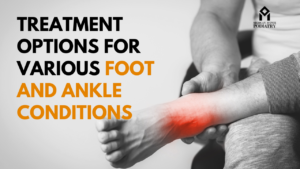Rheumatoid arthritis (RA) is an autoimmune disorder that primarily affects the joints, causing inflammation, pain, and stiffness. When RA affects the feet, it can significantly impact mobility and quality of life. In this comprehensive guide, we’ll explore the symptoms, diagnosis, and treatment options for rheumatoid arthritis in the feet, with insights from podiatrist experts and foot doctors.
Understanding Rheumatoid Arthritis Symptoms:
- Joint Pain and Stiffness: RA commonly affects the small joints of the feet, including the toes, ankles, and midfoot joints. Individuals with RA may experience pain, swelling, and stiffness in these joints, particularly in the morning or after periods of inactivity.
- Swelling and Inflammation: Inflammation is a hallmark feature of RA, leading to swelling and tenderness in the affected joints. Swollen joints in the feet can make it difficult to walk, wear shoes comfortably, or perform daily activities.
- Deformities: Over time, RA can cause joint deformities and changes in foot structure, such as bunions, hammertoes, or flat feet. These deformities can further exacerbate pain and discomfort, affecting mobility and balance.
- Nodules: Rheumatoid nodules, firm lumps of tissue, may develop beneath the skin of the feet, particularly over pressure points or bony prominences. While typically painless, these nodules can cause discomfort if they press on surrounding tissues or nerves.
- Fatigue: Chronic inflammation and pain associated with RA can lead to fatigue and decreased energy levels, impacting overall quality of life and ability to engage in daily activities.
Diagnosis and Treatment Options:
- Medical Evaluation: Diagnosis of RA in the feet typically involves a comprehensive medical history, physical examination, and diagnostic tests, such as blood tests and imaging studies. Podiatrists and foot doctors play a crucial role in assessing foot symptoms and coordinating care with rheumatologists and other healthcare providers.
- Medications:
- Disease-Modifying Antirheumatic Drugs (DMARDs): DMARDs such as methotrexate or hydroxychloroquine are commonly prescribed to manage RA symptoms and slow disease progression.
- Nonsteroidal Anti-Inflammatory Drugs (NSAIDs): NSAIDs can help reduce pain and inflammation in the feet during RA flare-ups.
- Corticosteroids: Short-term use of corticosteroid medications may be recommended to alleviate severe pain and inflammation in the feet.
- Foot Care Strategies:
- Custom Orthotic Inserts: Podiatrists can design custom orthotic inserts to provide support and cushioning for the feet, reducing pressure on inflamed joints and improving alignment.
- Proper Footwear: Choosing supportive shoes with cushioned soles and ample room for the toes can help alleviate foot pain and accommodate RA-related deformities.
- Physical Therapy: Gentle stretching and strengthening exercises prescribed by a physical therapist can improve joint flexibility, stability, and overall foot function.
- Lifestyle Modifications:
- Weight Management: Maintaining a healthy weight can reduce stress on the joints and alleviate symptoms of RA in the feet.
- Rest and Activity Modification: Balancing rest with gentle exercise and activity modification can help manage RA symptoms while avoiding excessive strain on the feet.
Conclusion: Rheumatoid arthritis in the feet can pose significant challenges, but with early diagnosis and comprehensive treatment, individuals can effectively manage symptoms and improve their quality of life. Consultation with podiatrist experts and foot doctors is essential for accurate diagnosis, personalized treatment planning, and ongoing foot care support for individuals living with RA. By understanding the symptoms and treatment options for RA in the feet, individuals can take proactive steps to preserve foot health and maintain mobility and function.
To schedule an appointment with our board-certified foot and ankle specialists, Book Your Appointment Now




